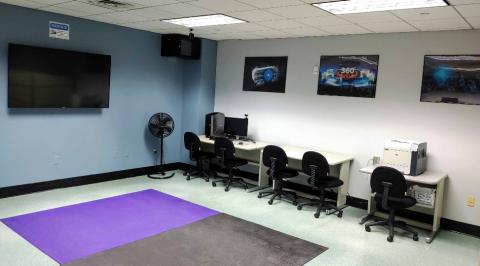
CSI’s Virtual Reality lab, is located in room 1C213, in the Campus Center. This room consists of an HTC Vice Pro running on a Dell Alienware Aurora, which is connected to a 65” Samsung display. In addition to this tethered system, there are also multiple portable Oculus Go’s and Oculus Quest headsets for use. Insta360 cameras and accessories are also available for those interested in creating their own VR experiences. This room is also under 24 video surveillance.
Use of VR to Practice Soft Skills
The use of virtual reality can assist students and faculty on their presentation skills by practicing in front of a virtual audience. Through the use of “Ovation” a virtual world can exist in order to confront speaking anxieties by repeated exposure to virtual simulations.
How do I get started?
First let’s get familiar with Ovation and practice your presentation skills. This can be done in “monitor mode” where VR equipment is not required. Monitor mode is available for anyone that has a windows-based computer and a user account. Please contact Linda.John@csi.cuny.edu if you would like an account to access Ovation.
Once you are familiar, then you should schedule an appointment to use the VR application in a more immersive environment. If you want to schedule an appointment to visit the VR lab, please contact: Linda.John@csi.cuny.edu
How Can You Use The Virtual Reality Lab?
- Before you can use any of the VR equipment, whether it is stationary units tethered to a PC, or portable devices, you will need to carefully read and sign the COLLEGE OF STATEN ISLAND VIRTUAL REALITY WAIVER OF LIABILITY AGREEMENT for your own awareness of health and safety issues involving VR.
- 1C213 is by appointment only, and when in use, it is manned by an Office of Information Technology Services (OITS) personnel, who will be there to provide information and assist you with the VR devices. If you would like to schedule time in the VR Lab, please fill out the Virtual Reality Lab Reservation Form.
- You must have a valid CSI email. After reading the rules and regulations, please press the “Submit” button. Your application will then be sent to HelpDesk, upon which an OITS personnel will contact you regarding your request.
How Can You Borrow VR Equipment?
- In order to borrow the VR headsets, please fill out The Virtual Reality Equipment Loan Form.
-
Image

You must have a valid CSI email. After reading the rules and regulations, please press the “Submit” button. Your application will then be sent to HelpDesk, upon which an OITS personnel will contact you regarding your request.
Health and Safety
- In order to sanitize and decontaminate shared electronic devices, the Virtual Reality lab has Cleanbox UVC technology to keep all devices safe for use.
Image
VR is well known in the arena of gaming. However, it can play a powerful role in enhancing faculty teaching and student learning. By having a fully “immersive” experience in a virtual world, students can benefit, no matter what discipline they are studying. Here are just some examples of how VR technology can be used in the classroom:
- Subjects such as chemistry, biology, anatomy, can be better understood by swimming through the bloodstream, delving into the various chambers of the heart, mixing chemicals to get different reactions while in the safety of the virtual world.
- Develop public speaking skills by working with VR applications that train you to present in front of various types of audiences, under different conditions. These apps will then test your ability by keeping track of your actions: eye movements, word repetitions, hand gestures, body language, etc…
- Physical therapy students can dissect the human body, multiple times, through different layers of muscle, tissue, bone, without the need for a real cadaver
- Travel famous landmarks and locations as you study historical events
- Ancient history can be better understood as you journey though cities and structures that no longer exist
- Get training in various fields, such as in medicine, law enforcement, manufacturing, etc…
- VR can be used to help individuals with accessibility issues to go beyond the limits of their disability.
- A person new to a wheelchair can learn to navigate through a virtual world of streets, traffic, and obstacles, thereby preparing them for the real world.
- Someone who has never walked can experience what it is to run, jump, dance, and participate in different sports.
- People who have autism can develop social skills, thereby allowing them to better communicate and achieve greater independence.
- VR can assist those suffering from PTSD (Post-Traumatic Stress Disorder)
- VR can also be a tool that helps people to have greater empathy and a better understanding of others. For example, VR can help people to experience what it is to be colorblind, or to be confined in a
wheelchair.

